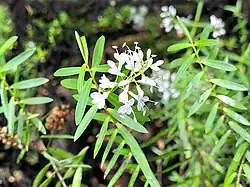Pasiphila heighwayi
| Pasiphila heighwayi | |
|---|---|

| |
| Holotype specimen | |
| Scientific classification | |
| Kingdom: | Animalia |
| Phylum: | Arthropoda |
| Class: | Insecta |
| Order: | Lepidoptera |
| Family: | Geometridae |
| Genus: | Pasiphila |
| Species: | P. heighwayi
|
| Binomial name | |
| Pasiphila heighwayi | |
| Synonyms[2] | |
| |
Pasiphila heighwayi is a moth in the family Geometridae.[1] It was first described by Alfred Philpott in 1927. This species is endemic to New Zealand and has been observed on the Banks Peninsular and in North Canterbury. Larvae feed on the flowers of Veronica traversii.
Taxonomy
This species was first described by Alfred Philpott in 1927 using specimens collected at Pukeatua Bush on Banks Peninsula in Canterbury by William Heighway and Stewart Lindsay in the last week of September.[3] In 1928 George Hudson discussed this species under that name in his book The butterflies and moths of New Zealand.[4] In 1971 John S. Dugdale placed this species in the genus Pasiphila.[5] The male holotype is held at the New Zealand Arthropod Collection.[2]
Description
Philpott described the adult male of this species as follows:
♂. 23–24 mm. Head, thorax and abdomen greyish-pink mixed with fuscous and black. Palpi 2, fuscous-grey with some white scales above. Antennae fasciculate-ciliate, greyish-pink annulated with fuscous basally, ciliations 3½. Legs ochreous-grey, densely irrorated with fuscous, tarsi annulated with ochreous-grey. Forewings triangular, costa slightly arched basally, subsinuate at middle, apex round-pointed, termen slightly bowed; pinkish-grey densely irrorated with fuscous; veins blackish; a series of very obscure darker irregular transverse lines, here and there margined with whitish, more pronounced at 1⁄4, before 1⁄2, and 2⁄3; an indistinct serrate subterminal line, interrupted above dorsum; a black line round termen: fringes pinkish-grey with median white line and indications of dark bars. Hindwings, termen moderate, sinuate below apex and above tornus leaving a broad blunt median projection; colour as in forewings but markings still more obscure; a dark discal dot: fringes as in forewings.[3]
Distribution
This species is endemic to New Zealand and has been observed on the Banks Peninsular as well as in the Waitohi River shrublands in North Canterbury.[6] This species is regarded as being rare.[6]
Habitat and hosts

The larvae feed on the flowers of Veronica traversii.[6]
References
- ^ a b "Pasiphila heighwayi (Philpott, 1927)". www.nzor.org.nz. Archived from the original on 2022-05-12. Retrieved 2025-08-06.
- ^ a b Dugdale , J. S. (23 September 1988). "Lepidoptera - annotated catalogue, and keys to family-group taxa". Fauna of New Zealand. 14. Department of Scientific and Industrial Research: 188. doi:10.7931/J2/FNZ.14. ISSN 0111-5383. Wikidata Q45083134.
- ^ a b Alfred Philpott (1927). "N.Z. Lepidoptera: notes and descriptions". Transactions and Proceedings of the New Zealand Institute. 57: 704–705. ISSN 1176-6158. Wikidata Q108109466.
 This article incorporates text from this source, which is in the public domain.
This article incorporates text from this source, which is in the public domain.
- ^ Hudson, G. V. (1928), The butterflies and moths of New Zealand, Illustrator: George Hudson, Wellington: Ferguson and Osborn Limited, p. 93, LCCN 88133764, OCLC 25449322, Wikidata Q58593286BHL page 61899704
 This article incorporates text from this source, which is in the public domain.
This article incorporates text from this source, which is in the public domain.
- ^ Dugdale, J. S. (10 November 1971). "Entomology of the Aucklands and other islands south of New Zealand: Lepidoptera, excluding non-crambine Pyralidae". Pacific Insects Monographs. 27: 106. ISSN 0078-7515. Wikidata Q64006453.
- ^ a b c Patrick, Brian H . (February 2012). Lepidoptera of the Waitohi River shrublands, North Canterbury (PDF) (Report). Archived from the original (PDF) on 2013-02-22. Retrieved 6 August 2023.